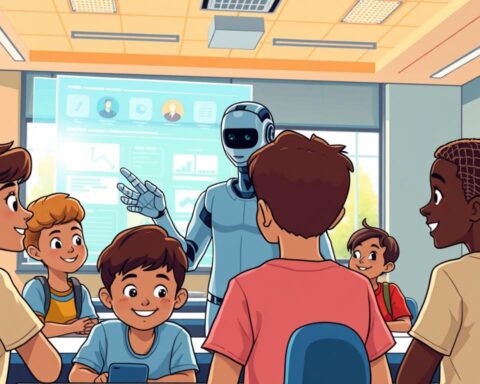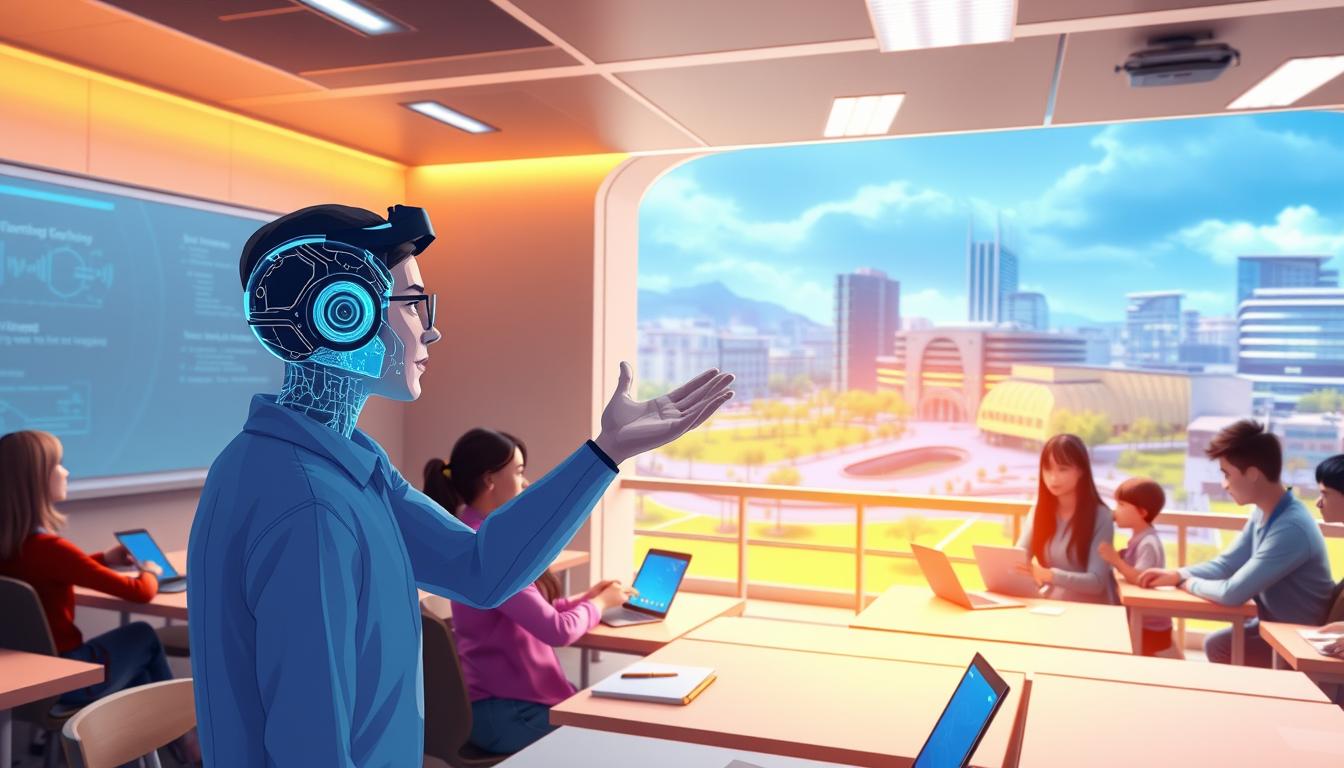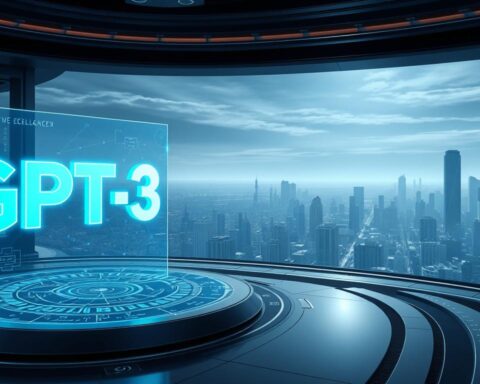The AI in education market is set to hit $20 billion by 2027. This shows how big AI’s role is becoming in schools. It’s changing how we learn and teach.
As the global AI market grows, so does the chance for new ideas in education. Entrepreneurs and teachers can make big changes. They can help students learn better and grow their businesses.
For example, artificial intelligence in education has made learning more personal. It has helped a language learning app go from 50% to 75% completion rates. This shows AI can really help students and keep them interested.
Key Takeaways
- The AI in education market is projected to reach $20 billion by 2027.
- AI in education and training has the power to change learning and teaching.
- Artificial intelligence in learning can help students do better and help businesses grow.
- The global e-learning market was worth $194.25 billion in 2022. It’s expected to hit $545.38 billion by 2030.
- Generative AI can make learning materials and make them fit different needs.
- E-learning sites that used generative AI saw a 25% boost in user interest. They also saw a 20% jump in course finishes.
- Integrating AI well means checking what you can do, picking the right tools, getting your data ready, and updating your tech.
Introduction to AI in Education and Training
Artificial intelligence (AI) is changing education a lot. It uses machine learning for education and AI tools for training more and more. The U.S. National Science Foundation (NSF) has spent over 30 years on AI research. This has led to big steps forward, like rules for teaching AI in schools.
AI is making learning better. It gives each student a special learning path. It also helps teachers by doing some work for them. AI tools for training make lessons fit each student’s needs. Machine learning for education finds where students need help.
- Adaptive learning systems that adjust to individual students’ learning styles and abilities
- Virtual tutors that provide one-on-one support and feedback to students
- Natural language processing that enables students to interact with AI systems in a more natural and intuitive way
As AI gets better, it will change education even more. It will bring new ways to learn and teach.
The Market Demand for AI Educational Tools
The need for AI educational tools is growing fast. This is because people want learning that fits them better. Also, digital tech is becoming more common in schools.
The global AI in education market is getting bigger. It’s important to know who these tools are for. Students, teachers, and schools all need these educational AI solutions.
By knowing what these groups need, makers can make AI-driven training programs. These programs should help the market grow. They should also fill gaps in AI education.
Developers need to make educational AI solutions that work well. They should help students learn better and make schools run smoother.
The AI in education market is expected to keep growing. It’s set to reach USD 5.82 billion by 2030. This growth will come from more AI in schools and a need for learning that fits each person.
As the market grows, makers must keep making new and good educational AI solutions. These solutions should meet the changing needs of everyone involved in education.
Key Features of Successful AI Educational Apps
When implementing AI in education, it’s key to know what makes an app great. AI helps make learning personal. It creates paths that fit each student’s needs and skills.
A good app also has a engaging user interface. This makes learning fun and interactive. It’s also important to have feedback right away. This lets students see how they’re doing and what they need to work on.
Some top features of great AI educational apps are:
- Personalization and customization
- Engaging user interfaces
- Real-time feedback mechanisms
These features help make AI in training work well. They lead to better learning and more students getting involved.
Technologies powering AI in Education
AI in education uses machine learning, natural language processing, and data analytics. These tools help make learning apps that learn with you. They also help teachers with tasks and make learning better for everyone.
Machine Learning Algorithms
Machine learning is key in AI for schools. It makes learning systems that change to fit each student. These systems learn from lots of data and help students learn better.
Natural Language Processing
Natural language processing is important too. It lets virtual tutors and chatbots talk to students like people. This makes learning fun and helps students understand better.
With these technologies, AI helps students learn in new ways. They get feedback and tests that change as they learn. This makes learning more fun and helps students do better in school.
Steps to Develop AI Educational Apps
Creating AI educational apps takes several steps. Developers start by conceptualizing and researching. They find out what the audience needs and look at the market. This helps them see what’s already out there and where they can be different.
Using artificial intelligence in learning is key. It makes learning personal for each student. AI helps change learning materials quickly to fit what each student needs.
Next, developers make a prototype and test it. They show the app to users to get feedback. This is important to make sure the app works well for its users.
After testing, the app is ready to go. Its success is checked by how well users do and how much they use it. By using AI, developers make apps that help students and teachers learn better.
Understanding the Regulatory Environment
Developers of AI educational apps face a complex world of rules. They must follow education standards and data privacy laws. This includes using machine learning for education and AI tools for training wisely.
Laws like FERPA, COPPA, and GDPR are key. They keep student data safe and make sure AI is fair and clear. For instance, FERPA asks schools to get parents’ okay before sharing student info with others.
COPPA says parents must agree before collecting personal info from kids under 13. To follow these rules, developers need to protect data well and get the right permissions.
Here are important things to think about:
- Being clear and getting consent
- Keeping data safe and secure
- Following education rules
By knowing the rules and following them, developers can make good AI tools for training. These tools can help students learn better while keeping their data safe.
Funding Opportunities for AI Educational Startups
Developers of educational AI solutions and AI-driven training programs can find many funding options. These help startups get the money they need to start and grow their apps.
California and NVIDIA are working together to give more AI tools to community colleges. They want to make sure everyone has a chance to learn about AI.
The Google for Startups Cloud Program also helps AI startups. They can get up to $2,000 in Google Cloud credits. Plus, they get to learn about AI and Google Cloud technology.
There are also venture capital and crowdfunding. These ways let developers get money from lots of people. People give money in exchange for rewards or a share of the company.
Some great things about these funding options are:
- Access to top AI tools and software
- Help and advice from experts
- More chances for everyone to learn about AI
By using these funding chances, developers can make their AI education ideas real. They can really help change education for the better.
Marketing Strategies for AI Educational Apps
AI has changed how we learn. Marketing for AI apps in education is key to their success. It shows the good things about AI in learning.
Developers need to tell people about these benefits. They can do this by being online, using social media, and working with schools. This helps more people use their apps.
Having a strong online presence is important. It helps developers show who they are and reach many people. They can use SEO to make their website easier to find.
They can also use social media to promote their apps. Many marketers use AI tools to help them.
Working with schools is also important. It helps developers reach their audience and get more people to use their apps. They can learn what educators and students need.
They can then make their marketing better. Some good strategies include:
- Using AI tools like Google Ads and Meta’s AI Sandbox to get more value
- Making content that is just for students and teachers, like emails and videos
- Using chatbots and virtual assistants to help users right away
By using these strategies, developers can reach more people. As AI in education grows, developers need to keep up. They must change their marketing to meet new needs.
Case Studies of Successful AI Educational Apps
AI has changed how we learn and teach. It helps teachers make learning fit each student’s needs. For example, Duolingo makes learning languages fun and easy.
Kahoot! turns learning into games. Teachers use it to make quizzes and games. These apps show how AI can help students learn better.

Apps like “Maths Pathway” at New Town High School help students in math. “Help Me See” at the University of Alicante helps visually impaired students. These examples show AI’s power in education.
Using AI in education opens new doors for learning. It lets teachers focus on teaching well. As we keep using AI, we’ll see even more ways to improve education.
Challenges in Developing AI Educational Apps
Creating AI educational apps is hard. There are technical limits, checking if the content is right, and making sure AI is fair. These issues need to be fixed for AI apps to work well and help students. AI in Education and Training needs careful thought to use AI’s full power in learning.
Some big challenges are:
- Technical limits, like needing good data and smart algorithms
- Checking if the content is correct and fits the needs
- Keeping AI fair and open, to avoid bias and keep things honest
Fixing these problems is key to making good AI educational apps. By knowing the challenges and chances of artificial intelligence in learning, makers can build apps that help students a lot.
Measuring Effectiveness of AI in Education
It’s important to check how well AI works in schools. Machine learning for education helps teachers see what needs work. A study with 92 students showed AI helps a lot.
AI tools make learning fit each student better. They give feedback right away. This helps students do better. For more on AI in schools, check this link.
AI has many good points. It makes learning just for you. It gives feedback fast. It helps students with special needs too.
Future Trends in AI and Education
AI is changing how we learn and teach. Educational AI solutions are making learning better. Virtual reality is making learning fun and real.
Studies show 97% of education leaders think AI helps a lot. AI-driven training programs are getting popular. But, only 56% of teachers use AI.
AI in education has many benefits. These include:
- Learning that fits each student
- More fun and interactive learning
- Better grades for students
We should look into educational AI solutions and AI-driven training programs more. They can make learning better and more fun. This way, students will be ready for the digital world.
Collaborations and Partnerships in AI Education
Working together is key in AI education. Teachers, developers, and tech companies share knowledge and tools. This helps make learning apps with AI better.
AI in schools brings many good things. Students get more involved and do better. They also remember what they learn longer.
AI helps in training too. It looks at lots of student data to find patterns. Then, it helps students learn better.
AI also helps students with special needs. It makes learning easier for everyone. Some important facts about AI in schools are:
- AI learning apps can make students more engaged and do better by up to 25%.
- AI cuts down on teachers’ paperwork. This lets them talk to students more, up to 40% more.
- AI learning is better for remembering things. It’s 25% better than old ways of learning.
By teaming up with tech and education experts, we can make learning with AI better. We can make learning more effective, efficient, and open to all.
Ethical Considerations in AI Educational Apps
AI in education is growing fast. We must think about the ethics of these tools. It’s key to make sure AI helps students fairly and openly.
The European Commission has rules for AI in schools. They talk about keeping human values and making choices wisely.
Studies show transparency and fairness are big in AI apps for learning. A study looked at 166 AI ethics courses worldwide. It showed we need ethics in AI teaching.
Also, 87% of teachers worry about keeping student data safe. But 92% think AI can make schools more welcoming for everyone.
- Ensuring equality in access to AI-powered educational tools
- Addressing bias in AI algorithms
- Maintaining transparency in AI decision-making
- Protecting student data privacy and security
By focusing on these ethics, AI developers can make tools that help students well. And they do it in a way that’s fair and open.
Conclusion: The Future of AI in Education and Training
The future of AI in education is changing fast. It could make learning better and help the education world grow. Teachers and developers need to be open to new ideas to make AI apps work well.
AI can make learning fit each student’s needs. It can even change content for different levels and languages. A study found 75% of teachers think AI will make learning more personal.
Successful AI in education shows it can help students who need extra help. It makes learning better for everyone.
Keeping AI apps up to date is very important. As AI gets better, we must think about its good and bad sides. The AI in education market is expected to grow a lot by 2025.
By always trying new things, we can make AI apps better. This will help students learn more and make education better for everyone.
FAQ
What is the current state of AI in education and training?
AI is changing how we learn and teach. The global AI market is worth over 4 billion in 2024. AI technologies like machine learning and natural language processing are making learning better.
What are the benefits of AI in education?
AI helps make learning personal and automates tasks. It also improves student results. Trends include adaptive learning and virtual tutors.
How can developers identify target audiences for AI educational tools?
Developers find their audience by looking at market gaps and understanding needs. They focus on students, teachers, and schools. This helps them create solutions that meet market demands and grow their business.
What are the key features of successful AI educational apps?
Good AI apps are personal and fun. They have engaging interfaces and give feedback right away. These features help students learn well and improve results.
What technologies are powering AI in education?
Machine learning, natural language processing, and data analytics are key. They help make new AI apps for education. These technologies keep getting better, making AI in education more powerful.
What are the steps to develop AI educational apps?
To make AI apps, start with research and planning. Then, test and refine your app. This ensures your app meets educational needs and grows your business.
What are the regulatory considerations for AI educational apps?
AI apps must follow education and data privacy rules. These rules are changing. Developers must keep up to avoid fines and protect their reputation.
What funding opportunities are available for AI educational startups?
Startups can get grants, venture capital, and crowdfunding. These help fund app development. They support innovation and growth in education.
What marketing strategies are effective for AI educational apps?
Use social media and partner with schools to promote apps. A strong online presence helps reach more people. This drives growth and improves student results.
What are some examples of successful AI educational apps?
Duolingo and Kahoot! are examples. They’ve changed language learning and education. They show AI’s power to innovate in education.
What are the challenges in developing AI educational apps?
Overcoming technical hurdles and ensuring fairness are big challenges. Developers must tackle bias and transparency. This makes apps effective and improves student results.
How can the effectiveness of AI in education be measured?
Use KPIs, feedback, and how well the app adapts. This shows AI’s impact on learning. It helps improve apps and student results.
What are the future trends in AI and education?
Virtual reality and AI in training are future trends. They promise to change education. They offer new ways to innovate and grow.
Why are collaborations and partnerships important in AI education?
Working together brings expertise and resources. It drives innovation and growth. Partnerships help create solutions that meet student needs and grow businesses.
What are the ethical considerations in AI educational apps?
Fairness, equality, and transparency are key. Developers must ensure AI systems are just and open. This makes apps effective and improves student outcomes.
Source Links
- Generative AI for Educators – Grow with Google – https://grow.google/ai-for-educators/
- Turn AI into Profit for Your E-Learning Business – https://www.linkedin.com/pulse/turn-ai-profit-your-e-learning-business-processica-igzqf
- AI education and AI in education – https://www.nsf.gov/science-matters/ai-education-ai-education
- Introduction to Teaching with Artificial Intelligence (AI) – https://www.gse.upenn.edu/academics/center-professional-learning/introducing-artificial-intelligence-ai-classroom
- The role of AI in modern education – https://onlineprograms.education.uiowa.edu/blog/role-of-ai-in-modern-education
- AI In Education Market Size & Share | Industry Report, 2030 – https://www.grandviewresearch.com/industry-analysis/artificial-intelligence-ai-education-market-report
- AI in Education Market Trends and Revenue Forecast (2024-2032) by Component, Application, End User, and Country, with Detailed Company Analysis – https://www.globenewswire.com/news-release/2024/12/13/2996850/28124/en/AI-in-Education-Market-Trends-and-Revenue-Forecast-2024-2032-by-Component-Application-End-User-and-Country-with-Detailed-Company-Analysis.html
- Artificial Intelligence (AI) in Education Market | Size, Share, Growth | 2024 – 2030 – https://virtuemarketresearch.com/report/artificial-intelligence-ai-in-education-market
- Artificial Intelligence In Education: Teachers’ Opinions On AI In The Classroom – https://www.forbes.com/advisor/education/it-and-tech/artificial-intelligence-in-school/
- AI in Education: Use Cases, Challenges & Tools (2025) – https://www.synthesia.io/learn/ai-applications/education
- III. The Current State of Artificial Intelligence in Education | NEA – https://www.nea.org/resource-library/artificial-intelligence-education/iii-current-state-artificial-intelligence-education
- AI in Education – Powering Higher Education Beyond 2025 – https://www.edtechdigit.com/research-and-insights/ai-in-education-powering-higher-education-beyond-2025
- 7 AI Tools That Help Teachers Work More Efficiently – https://www.edutopia.org/article/7-ai-tools-that-help-teachers-work-more-efficiently/
- ChatGPT and Beyond: How to Handle AI in Schools | Common Sense Education – https://www.commonsense.org/education/articles/chatgpt-and-beyond-how-to-handle-ai-in-schools
- AI and the Law: What Educators Need to Know – https://www.edutopia.org/article/laws-ai-education/
- Implementing effective AI compliance amid an evolving regulatory landscape – https://globalinvestigationsreview.com/guide/the-guide-compliance/third-edition/article/implementing-effective-ai-compliance-amid-evolving-regulatory-landscape
- A comprehensive AI policy education framework for university teaching and learning – International Journal of Educational Technology in Higher Education – https://educationaltechnologyjournal.springeropen.com/articles/10.1186/s41239-023-00408-3
- California, NVIDIA launch first-of-its-kind AI collaboration | Governor of California – https://www.gov.ca.gov/2024/08/09/california-nvidia-launch-first-of-its-kind-ai-collaboration/
- Iterate and innovate faster with our AI startup program – https://cloud.google.com/startup/ai
- AI in Education Marketing: What Schools Should Know – https://www.higher-education-marketing.com/blog/ai-in-education-marketing-4-insights-and-strategies-for-schools
- 6 AI Marketing Strategies for Higher Ed – https://element451.com/blog/6-ai-marketing-strategies-for-higher-ed
- Use of AI in Schools [25 Case Studies] [2025] – https://digitaldefynd.com/IQ/ai-in-schools-case-studies/
- 5 AI Case Studies in Education | VKTR – https://www.vktr.com/ai-disruption/5-ai-case-studies-in-education/
- AI in Education – https://www.educationnext.org/a-i-in-education-leap-into-new-era-machine-intelligence-carries-risks-challenges-promises/
- Artificial Intelligence (AI) in Education: Benefits, Challenges, and Applications – https://tokyotechlab.com/blogs/artificial-intelligence-ai-in-education
- The Promises and Challenges of Artificial Intelligence for Teachers: a Systematic Review of Research – TechTrends – https://link.springer.com/article/10.1007/s11528-022-00715-y
- Exploring the Effectiveness of AI Course Assistants on the Student Learning Experience | Open Praxis – https://openpraxis.org/articles/10.55982/openpraxis.16.4.719
- AI in Schools: Pros and Cons – https://education.illinois.edu/about/news-events/news/article/2024/10/24/ai-in-schools–pros-and-cons
- AI in Education in 2024: Educators Express Mixed Feelings on the Technology’s Future – https://edtechmagazine.com/k12/article/2024/09/ai-education-2024-educators-express-mixed-feelings-technologys-future-perfcon
- The Future of AI in Education: Pioneering a New Era of Learning — ITRex – https://itrexgroup.com/blog/the-future-of-ai-in-education-pioneering-a-new-era-of-learning/
- Embracing the future of Artificial Intelligence in the classroom: the relevance of AI literacy, prompt engineering, and critical thinking in modern education – International Journal of Educational Technology in Higher Education – https://educationaltechnologyjournal.springeropen.com/articles/10.1186/s41239-024-00448-3
- AI And Education: A Collaborative Approach – https://elearningindustry.com/ai-and-education-a-collaborative-approach
- Human and AI collaboration in the higher education environment: opportunities and concerns – Cognitive Research: Principles and Implications – https://cognitiveresearchjournal.springeropen.com/articles/10.1186/s41235-024-00547-9
- Research and Development Partnerships Using AI to Support Students with Disabilities – https://ies.ed.gov/learn/blog/research-and-development-partnerships-using-ai-support-students-disabilities
- Ethical issues of the use of AI-driven mobile apps for education – https://pmc.ncbi.nlm.nih.gov/articles/PMC9874223/
- Ethical Considerations In AI-Powered Education – Izen – https://izen.ai/2023/11/27/ethical-considerations-in-ai-powered-education/
- 5 Pros and Cons of AI in the Education Sector – https://www.waldenu.edu/programs/education/resource/five-pros-and-cons-of-ai-in-the-education-sector
- Predicting The Future Of AI In Education And Training – https://elearningindustry.com/predicting-the-future-of-ai-in-education-and-training
- Artificial Intelligence and the Future of Teaching and Learning – https://www.engageli.com/blog/artificial-intelligence-and-the-future-of-teaching-and-learning










